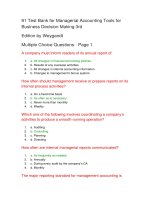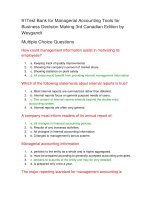Managerial accounting tools for business decision making 7th edition by weygandt kimmel kieso solution manual
Bạn đang xem bản rút gọn của tài liệu. Xem và tải ngay bản đầy đủ của tài liệu tại đây (805 KB, 51 trang )
Managerial Accounting: Tools for Business Decision
Making 7th edition by Jerry J. Weygandt, Paul D.
Kimmel, Donald E. Kieso Solution Manual
Link full download:
/>
CHAPTER 2. Job Order Costing
ASSIGNMENT CLASSIFICATION TABLE
Learning Objectives
1.
2.
3.
4.
5.
Describe cost systems and
the flow of costs in a job
order system.
Questions
Brief
Exercises
Do It!
Exercises
A
Problems
1, 2, 3, 4, 5,
6, 7, 8
1, 2
1
1, 2, 3, 4, 6, 1A, 2A, 3A,
7, 8, 9, 11
5A
9, 10, 11, 12
3, 4, 5
2
1, 2, 3, 6, 7, 1A, 2A, 3A,
8, 10, 12
5A
13, 14, 15
6, 7
3
2, 3, 5, 6, 7, 1A, 2A, 3A,
8, 11, 12, 13
4A, 5A
Prepare entries for
manufacturing and service
jobs completed and sold.
16
8, 9
4
2, 3, 6, 7, 8, 1A, 2A, 3A,
10, 11, 12
5A
Distinguish between underand overapplied
manufacturing overhead.
17, 18
10
5
Use a job cost sheet to
assign costs to work in
process.
Demonstrate how to
determine and use the
predetermined overhead
rate.
4, 5, 9, 13
1A, 2A, 3A,
4A, 5A
Copyright © 2015 John Wiley & Sons, Inc. Weygandt, Managerial Accounting, 7/e, Solutions Manual (For Instructor Use Only)
ASSIGNMENT CHARACTERISTICS TABLE
Problem
Number
Description
Difficulty
Level
Time
Allotted (min.)
2-1
2-2
1A
Prepare entries in a job order cost system and job cost
sheets.
Simple
30 40
2A
Prepare entries in a job order cost system and partial
income statement.
Moderate
30 40
3A
Prepare entries in a job order cost system and cost of
goods manufactured schedule.
Simple
30 40
4A
Compute predetermined overhead rates, apply overhead,
and calculate under- or overapplied overhead.
Simple
20 30
5A
Analyze manufacturing accounts and determine missing
amounts.
Complex
30 40
Copyright © 2015 John Wiley & Sons, Inc. Weygandt, Managerial Accounting, 7/e, Solutions Manual (For Instructor Use Only)
Learning Objective
Knowledge
Comprehension
1. Describe cost systems and the
flow of costs in a job order
system.
Q2-5
Q2-7
Q2-8
Q2-1
Q2-2
Q2-3
2. Use a job cost sheet to assign
costs to work in process.
Q2-11
Q2-12
Q2-9 Q210
3. Demonstrate how to determine
and use the predetermined
overhead rate.
Q2-15
Application
Q2-4
BE2-2
Q2-6
DI2-1
BE2-1 E2-1
E2-2
E2-3
Analysis
E2-6
E2-7
E2-8
E2-9
E2-11
P2-1A P2-2A
P2-3A P2-5A
E2-4
BE2-3
BE2-4
BE2-5
DI2-2
E2-1
E2-2
E2-3
E2-6
E2-7
E2-8
E2-10 P2-2A
E2-12 P2-5A
P2-1A
P2-3A
Q2-13
Q2-14
BE2-6
BE2-7
DI2-3
E2-2
E2-3
E2-6
E2-7
E2-8
E2-11
E2-12
E2-13
P2-1A E2-5
P2-3A P2-2A
P2-4A P2-5A
4. Prepare entries for manufacturing
and service jobs completed and
sold.
Q2-16 BE29
BE2-8
DI2-4
E2-2
E2-3
E2-6
E2-7
E2-8
E2-10
E2-11 P2-2A
E2-12 P2-5A
P2-1A
P2-3A
5. Distinguish between under- and
overapplied manufacturing
overhead.
Q2-17
Q2-18
E2-9
BE2-10
E2-13
P2-1A
P2-3A
P2-4A
DI2-5 P2-2A E2-4
P2-5A
E2-5
Synthesis
Evaluation
Broadening Your Perspective
BYP2-3
BYP2-4
CD-2
BYP2-2
BYP2-1
BYP2-5
BYP2-6
BYP2-7
Correlation Chart between Bloom’s Taxonomy, Learning Objectives and End-of-Chapter Exercises and Problems
ANSWERS TO QUESTIONS
1.
(a) Cost accounting involves the measuring, recording, and reporting of product costs. A cost accounting
system consists of manufacturing cost accounts that are fully integrated into the general ledger of a
company.
(b) An important feature of a cost accounting system is the use of a perpetual inventory system that provides
immediate, up-to-date information on the cost of a product.
2.
(a) The two principal types of cost accounting systems are: (1) job order cost system and (2) process cost
system. Under a job order cost system, costs are assigned to each job or batch of goods; at all times each
job or batch of goods can be separately identified. A job order cost system measures costs for each
completed job, rather than for set time periods. Under a process cost system, product-related costs are
accumulated by or assigned to departments or processes for a set period of time. Job order costing lends
itself to specific, special-order manufacturing or servicing while process costing is better suited to similar,
largevolume products and continuous process manufacturing.
(b) A company can use both types of systems. For example, General Motors uses process costing for
standard model cars and job order costing for custom-made vehicles.
3.
A job order cost system is most likely to be used by a company that receives special orders, or custom
builds, or produces heterogeneous items or products; that is, the product manufactured or the service
rendered is tailored to the customer or client’s requests, needs, or situation. Examples of industries that
use job order systems are custom home builders, commercial printing companies, motion picture
companies, construction contractors, repair shops, accounting and law firms, hospitals, shipbuilders, and
architects.
4.
A process cost system is most likely to be used by manufacturing firms with continuous production flows
usually found in mass production, assembly line, large-volume, uniform, or relatively similar product
industries. Companies producing appliances, chemicals, pharmaceuticals, rubber and tires, plastics,
cement, petroleum, and automobiles utilize process cost systems.
5.
The major steps in the flow of costs in a job order cost system are: (1) accumulating the manufacturing
costs incurred and (2) assigning the accumulated costs to work done.
6.
The three inventory control accounts and their subsidiary ledgers are:
Raw materials inventory—materials inventory records.
Work in process inventory—job cost sheets.
Finished goods inventory—finished goods records.
7.
The source documents used in accumulating direct labor costs are time tickets and time cards.
8.
Disagree. Entries to Manufacturing Overhead are also made at the end of an accounting period. For
example, there will be adjusting entries for factory depreciation, property taxes, and insurance.
9.
The source document for materials is the materials requisition slip and the source document for
labor is the time ticket. The entries are:
Weygandt, Managerial Accounting,
Solutions Manual (
2-7
Materials
Labor
Work in Process Inventory XX Work in Process Inventory XX Manufacturing Overhead XX Manufacturing
Overhead XX
Raw Materials Inventory
XX
Factory Labor
XX
2-4
Copyright © 2015 John Wiley & Sons, Inc. Weygandt, Managerial Accounting, 7/e, Solutions Manual (For Instructor Use Only)
Questions Chapter 2 (Continued)
10.
The purpose of a job cost sheet is to record the costs chargeable to a specific job and to determine the
total and unit costs of the completed job.
11.
The source documents for charging costs to specific jobs are materials requisition slips for direct materials,
time tickets for direct labor, and the predetermined overhead rate for manufacturing overhead.
12.
The materials requisition slip is a business document used as an authorization to issue materials from
inventory to production. It is approved and signed by authorized personnel so that materials may be
removed from inventory and charged to production, to specific jobs, departments, or processes. The
materials requisition slip is the basis for posting to the materials inventory records and to the job cost sheet.
13.
Disagree. Actual manufacturing overhead cannot be determined until the end of a period of time.
Consequently, there could be a significant delay in assigning overhead and in determining the total cost of
the completed job.
14.
The relationships for computing the predetermined overhead rate are the estimated annual overhead costs
and an expected activity base such as direct labor hours. The rate is computed by dividing the estimated
annual overhead costs by the expected annual operating activity.
15.
At any point in time, the balance in Work in Process Inventory should equal the sum of the costs shown on
the job cost sheets of unfinished jobs. Alternatively, posting to Work in Process Inventory may be compared
with the sum of the postings to the job cost sheets for each of the manufacturing cost elements.
16.
Jane is incorrect. There is a difference in computing total manufacturing costs. In job order costing,
manufacturing overhead applied is used, whereas in Chapter 1, actual manufacturing overhead is used.
17.
Underapplied overhead means that the overhead assigned to work in process is less than the overhead
incurred. Overapplied overhead means that the overhead assigned to work in process is greater than the
overhead incurred. Manufacturing Overhead will have a debit balance when overhead is underapplied and
a credit balance when overhead is overapplied.
18.
Under- or overapplied overhead is not closed to Income Summary. The balance in Manufacturing
Overhead is eliminated through an adjusting entry. Under- or overapplied overhead generally is considered
to be an adjustment of Cost of Goods Sold.
Copyright © 2015 John Wiley & Sons, Inc.
7/e,
Weygandt, Managerial Accounting,
For Instructor Use Only)
Solutions Manual (
2-9
Raw Materials Inventory
Work in Process Inventory
Finished Goods Inventory
BRIEF EXERCISE 2-2
Jan. 31
31
31
Raw Materials Inventory ......................................
Accounts Payable .........................................
4,000
Factory Labor .......................................................
Factory Wages Payable ................................
Employer Payroll Taxes Payable .................
6,000
Manufacturing Overhead .....................................
Utilities Payable ............................................
2,000
4,000
5,200
800
2,000
BRIEF EXERCISE 2-3
Jan. 31
Work in Process Inventory ..................................
Manufacturing Overhead .....................................
Raw Materials Inventory ...............................
2,800
600
3,400
BRIEF EXERCISE 2-4
Jan. 31
Work in Process Inventory ..................................
Manufacturing Overhead .....................................
Factory Labor ...............................................
5,200
800
6,000
BRIEF EXERCISE 2-5
Date
1/31
1/31
Job 1
Direct
Materials
900
Job 2
Date
Direct
Materials
1/31
1,200
1/31
Direct
Labor
2,200
Direct
Labor
1,600
Job 3
Copyright © 2015 John Wiley & Sons, Inc. Weygandt, Managerial Accounting, 7/e, Solutions Manual (For Instructor Use Only)
2-13
Date
1/31
1/31
Direct
Materials
700
Direct
Labor
1,400
BRIEF EXERCISE 2-6
Overhead rate per direct labor cost is 180%, or ($900,000 ÷ $500,000).
Overhead rate per direct labor hour is $18, or ($900,000 ÷ 50,000 DLH).
Overhead rate per machine hour is $9, or ($900,000 ÷ 100,000 MH).
BRIEF EXERCISE 2-7
Jan. 31
Feb. 28
Mar. 31
Work in Process Inventory .............................
Manufacturing Overhead
($40,000 X 70%) ....................................
28,000
Work in Process Inventory .............................
Manufacturing Overhead
($30,000 X 70%) ....................................
21,000
Work in Process Inventory .............................
Manufacturing Overhead
($50,000 X 70%) ....................................
35,000
28,000
21,000
35,000
BRIEF EXERCISE 2-8
Mar. 31
Finished Goods Inventory ..............................
50,000
Work in Process Inventory
......................
31
Cash .................................................................
Sales Revenue
.........................................
31 Cost of Goods Sold .........................................
50,000
35,000
35,000
20,000
Copyright © 2015 John Wiley & Sons, Inc. Weygandt, Managerial Accounting, 7/e, Solutions Manual (For Instructor Use Only)
Finished Goods Inventory .......................
20,000
BRIEF EXERCISE 2-9
Service Contracts in Process .........................
28,000
Operating Overhead ........................................
8,000
Service Salaries and Wages ...................
Service Contracts in Process
($28,000 X .25) ..........................................
36,000
7,000
Operating Overhead ................................
7,000
BRIEF EXERCISE 2-10
Dec. 31
Dec. 31
Shimeca Company
Cost of Goods Sold .........................................
Manufacturing Overhead ........................
1,200
Garcia Company
Manufacturing Overhead ................................
Cost of Goods Sold .................................
900
1,200
900
SOLUTIONS FOR DO IT! REVIEW EXERCISES
DO IT! 2-1
(a) Raw Materials Inventory ............................................ 18,000
Accounts Payable ...............................................
18,000
(Purchases of raw materials on account)
(b) Factory Labor .............................................................
Factory Wages Payable ......................................
40,000
Copyright © 2015 John Wiley & Sons, Inc. Weygandt, Managerial Accounting, 7/e, Solutions Manual (For Instructor Use Only)
31,000
2-15
Employer Payroll Taxes Payable ........................
factory labor costs)
9,000
(c) Manufacturing Overhead ..........................................
Accumulated Depreciation—Buildings ..............
Utilities Payable ...................................................
Prepaid Property Taxes ......................................
(To record overhead costs)
(To record
15,300
9,500
3,100
2,700
DO IT! 2-2
The three summary entries are:
Work in Process Inventory ($7,200 + $9,000) ..................
16,200
Raw Materials Inventory ............................................
(To assign materials to jobs)
16,200
Work Process Inventory ($4,000 + $8,000) ......................
12,000
Factory Labor .............................................................
(To assign labor to jobs)
12,000
Work in Process Inventory ($5,200 + $9,800) ..................
Manufacturing Overhead ..........................................
assign overhead to jobs)
15,000
(To
DO IT! 2-3
The predetermined overhead for Washburn Company is:
$200,000
2,500 hours = $80.00
The amount of overhead assigned to number 551 would be:
90 hours
$80.00 = $7,200
Copyright © 2015 John Wiley & Sons, Inc. Weygandt, Managerial Accounting, 7/e, Solutions Manual (For Instructor Use Only)
15,000
The entry to record the assignment of overhead to job number 551 on
January 15th is:
January 15 Work in Process Inventory .........................
Manufacturing Overhead .......................
(To assign overhead to jobs)
DO IT! 2-4
Finished Goods Inventory ................................................
7,200
7,200
120,000
Work in Process Inventory ........................................
(To record completion of Job 310, costing
$70,000 and Job 312, costing $50,000)
Accounts Receivable ........................................................
120,000
90,000
Sales Revenue .........................................................
(To record sale of Job 312)
Cost of Goods Sold ...........................................................
90,000
50,000
Finished Goods Inventory .........................................
(To record cost of goods sold for Job 312)
50,000
DO IT! 2-5
Manufacturing overhead applied = 130% X $85,000 = $110,500
Underapplied manufacturing overhead = $115,000 – $110,500 = $4,500
Copyright © 2015 John Wiley & Sons, Inc. Weygandt, Managerial Accounting, 7/e, Solutions Manual (For Instructor Use Only)
2-17
SOLUTIONS TO EXERCISES
EXERCISE 2-1
(a) Factory Labor ..........................................................
90,000
Factory Wages Payable ..................................
Employer Payroll Taxes Payable ....................
Employer Fringe Benefits Payable .................
(b) Work in Process Inventory ($90,000 X 85%) .........
Manufacturing Overhead ........................................
76,000
8,000
6,000
76,500
13,500
Factory Labor ..................................................
90,000
EXERCISE 2-2
(a) May 31
Work in Process Inventory ....................
10,400
Manufacturing Overhead .......................
800
Raw Materials Inventory
................
31
11,200
Work in Process Inventory ....................
12,500
Manufacturing Overhead .......................
1,200
Factory Labor ..................................
31
Work in Process Inventory
($12,500 X 60%) ..................................
13,700
7,500
Manufacturing Overhead
7,500
...............
31
Finished Goods Inventory .....................
7,540
Work in Process Inventory .............
($2,000 + $2,500 + $1,900 + $1,140*)
Copyright © 2015 John Wiley & Sons, Inc. Weygandt, Managerial Accounting, 7/e, Solutions Manual (For Instructor Use Only)
7,540
*$1,900 X 60%
(b)
Work in Process Inventory
May 1 Balance
3,500 May 31
31
10,400
31
12,500
31
7,500
May 31 Balance
26,360
Copyright © 2015 John Wiley & Sons, Inc. Weygandt, Managerial Accounting, 7/e, Solutions Manual (For Instructor Use Only)
7,540
2-19
EXERCISE 2-2 (Continued)
Job Cost Sheets
Beginning Work
Job
in Pro cess
No.
$1,800
431
0 4,400
Direct
Mate rial
Direct
Labor
Manufacturing*
Overhead
Total
430
$1,500
$3,500 $
3,000
$ 9,800
7,600 4,560 16,560 $1,500 $7,900 $10,600 $6,360 $26,360
*Direct labor X .60
EXERCISE 2-3
(a) 1. $15,200, or ($5,000 + $6,000 + $4,200).
2. Last year 70%, or ($4,200 ÷ $6,000); this year 80% (either $6,400 ÷
$8,000 or $3,200 ÷ $4,000).
(b) Jan. 31
Work in Process Inventory ......................
8,000
Raw Materials Inventory ...................
31
31
31
2-20
8,000
Work in Process Inventory ......................
Factory Labor ....................................
12,000
Work in Process Inventory ......................
Manufacturing Overhead ..................
9,600
Finished Goods Inventory .......................
Work in Process Inventory ...............
44,800
12,000
9,600
Copyright © 2015 John Wiley & Sons, Inc. Weygandt, Managerial Accounting, 7/e, Solutions Manual (For Instructor Use Only)
44,800
EXERCISE 2
EXERCISE 2-4
(a) + $50,000 + $42,500 = $145,650
(a) = $53,150
$145,650 + (b) = $201,500
(b) = $55,850
$201,500 – (c) = $192,300
(c) = $9,200
4 (Continued)
[Note: The instructions indicate that manufacturing overhead is applied on the basis
of direct labor cost, and the rate is the same in all cases. From Case A, a student
should note the overhead rate to be 85%, or ($42,500 ÷ $50,000).]
(d) = .85 X $140,000
(d) = $119,000
$83,000 + $140,000 + $119,000 = (e)
(e) = $342,000
$342,000 + $15,500 = (f)
(f) = $357,500
$357,500 – $11,800 = (g)
(g) = $345,700
[Note: (h) and (i) are solved together.]
(i) = .85(h)
$63,150 + (h) + .85(h) = $213,000
1.85(h) = $149,850
(h) = $81,000
(i) = $68,850
Copyright © 2015 John Wiley & Sons, Inc. Weygandt, Managerial Accounting, 7/e, Solutions Manual (For Instructor Use Only)
2-21
EXERCISE 2(j) = $213,000 + $18,000
(j) = $231,000
$231,000 – (k) = $222,000
(k) = $9,000
EXERCISE 2-5
(a) $2.40 per machine hour ($300,000 ÷ 125,000 MH).
(b) ($322,000) – ($2.40 x 130,000 Machine Hours)
$322,000 – $312,000 = $10,000 underapplied
(c) Cost of Goods Sold ..................................................
Manufacturing Overhead ..................................
10,000
10,000 -6
(a) (1) The source documents are:
Direct materials—Materials requisition slips.
Direct labor—Time tickets.
Manufacturing overhead—Predetermined overhead rate.
(2) The predetermined overhead rate is 125% of direct labor cost. For example, on July
15, the computation is $550 ÷ $440 = 125%. The same result is obtained on July 22
and 31.
(3) The total cost is:
Direct materials ............................................................
$4,700
Direct labor ...................................................................
1,360
Manufacturing overhead..............................................
1,700
$7,760
The unit cost is $3.10 ($7,760 ÷ 2,500).
(b) July 31
2-22
Finished Goods Inventory ............................
7,760
Work in Process Inventory ...................
Copyright © 2015 John Wiley & Sons, Inc. Weygandt, Managerial Accounting, 7/e, Solutions Manual (For Instructor Use Only)
7,760
EXERCISE 2
EXERCISE 2-7
1.
2.
3.
Raw Materials Inventory ................................................ 46,300
Accounts Payable ..................................................
46,300
Work in Process Inventory ............................................ 29,200
Manufacturing Overhead ............................................... 6,800
Raw Materials Inventory ........................................
36,000
Factory Labor ................................................................. 59,900
Factory Wages Payable .........................................
Employer Payroll Taxes Payable ..........................
51,000
8,900
4.
Work in Process Inventory ............................................ 54,000
Manufacturing Overhead ............................................... 5,900
Factory Labor .........................................................
59,900
(Continued)
5.
6.
7.
8.
9.
Manufacturing Overhead ....................................... 80,500
Accounts Payable ..........................................
Depreciation Expense ........................................... 8,100
Accumulated Depreciation—Building ...........
80,500
8,100
Work in Process Inventory ($54,000 X 150%) ...... 81,000
Manufacturing Overhead ...............................
81,000
Finished Goods Inventory ..................................... 88,000
Work in Process Inventory ............................
88,000
Accounts Receivable ............................................. 103,000
Sales Revenue ................................................
103,000
Cost of Goods Sold ...............................................
7
75,000
Copyright © 2015 John Wiley & Sons, Inc. Weygandt, Managerial Accounting, 7/e, Solutions Manual (For Instructor Use Only)
2-23
EXERCISE 2Finished Goods Inventory .............................
75,000
EXERCISE 2-8
1.
Raw Materials Inventory ........................................ 192,000
Accounts Payable ..........................................
Factory Labor .........................................................
Factory Wages Payable .................................
2.
87,300
87,300
Work in Process Inventory .................................... 153,530
Manufacturing Overhead .......................................
4,470
Raw Materials Inventory ................................
Work in Process Inventory ....................................
Manufacturing Overhead .......................................
Factory Labor .................................................
192,000
158,000
80,000
7,300
Manufacturing Overhead ....................................... 49,500
Accounts Payable ..........................................
(Continued)
87,300
3.
4.
5.
6.
7.
2-24
49,500
-8
Manufacturing Overhead ....................................... 14,550
Accumulated Depreciation—Equipment ......
14,550
Depreciation Expense ............................................ 14,300
Accumulated Depreciation—Building ...........
14,300
Work in Process Inventory ..................................... 72,000
Manufacturing Overhead
(90% X $80,000) ...........................................
72,000
Finished Goods Inventory ...................................... 240,930
Copyright © 2015 John Wiley & Sons, Inc. Weygandt, Managerial Accounting, 7/e, Solutions Manual (For Instructor Use Only)
EXERCISE 2
Work in Process Inventory .............................
240,930
Computation of cost of jobs finished:
Direct
Direct
Job
Mate rials
Labor
A20
A21
A23
$35,240
42,920
39,270
$18,000
22,000
25,000
Manufacturing
Overhead
Total
$16,200
19,800
22,500
$ 69,440
84,720
86,770
$240,930
EXERCISE 2-9
(a)
LOPEZ COMPANY
Cost of Goods Manufactured Schedule
For the Month Ended May 31, 2017
Work in process, May 1 ........................................
Direct materials used ...........................................
Direct labor ............................................................
Manufacturing overhead applied .........................
Total manufacturing costs ...........................
Total cost of work in process ..............................
Less: Work in process, May 31 ...........................
(b)
$ 14,700
$62,400
50,000
40,000
152,400
167,100
15,900
LOPEZ COMPANY
(Partial) Income Statement
For the Month Ended May 31, 2017
Sales revenue .....................................................
Cost of goods sold
$215,000
Copyright © 2015 John Wiley & Sons, Inc. Weygandt, Managerial Accounting, 7/e, Solutions Manual (For Instructor Use Only)
2-25









